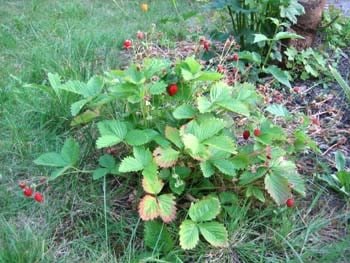
I’ve always been a fan of sweet alpine strawberries (Fragaria vesca, Zone 4), the small intensely flavoured little berries also known as fraises des bois, and often found in European tarts and fruit salads. As well as being delicious to eat, they grow on attractive perennial plants that make a good groundcover, or edging for a border or garden path. These charming plants with attractive foliage and pretty white flowers produce fruits in their first season (beginning in July) when grown from seed, making neat clumps in partial shade without renegade runners. They’re completely undemanding, and only need regular irrigation to stay productive from late spring through autumn.
Alpine strawberries are easy to grow from seed, good news if you’re interested in new varieties becoming available. I’m looking for white and yellow alpine strawberries, which are less hardy than red-fruited plants, but said to have the sweetest and most exotic flavour. ‘White Soul’ (Zone 6, richters.com and halifaxseed.ca) is heavy bearing and makes plump berries with a slight pineapple tang. The same pineapple essence lurks in ‘Pineapple Crush’ (Zone 6) and ‘Yellow Wonder’ (Zone 4), both available at strawberryseedstore.com. They produce long, pointed berries.
Despite their strongly perfumed fruits, white and yellow strawberries are reputed to fool chickens and birds, appearing unripe when at their peak of flavour. (However, they do not fool small boys.) If birds can see colours, they may wait for and recognize red colouration to signal ripeness. But these pale and exotic little strawberries seem to fool them, and are left untouched.
Of course, if you’re interested in growing traditional red alpine strawberries, there is seed available for several good plants. ‘Mignonette’ (Zone 6, damseeds.ca) and ‘Alexandria’ (Zone 6, swallowtailgardenseeds.com ) make continuous crops of rounded, deep red fruits all summer. These could possibly be grown in Zone 5 if given a thick mulch of leaves over winter. ‘Ruegen’ and ‘Ruegen Improved’ (Zone 4, figsforlife.ca) are hardier, and often available as started perennial plants in spring at garden centres, or through plant catalogues.
Alpine strawberry seeds are slow to germinate, but they’ll fruit in their first season if started in mid-winter. Sprinkle the seed on the surface of moist soilless mix in a pot or in cell packs. Slip the pot into a plastic bag and leave it at cool room temperature (15° to 18°C) in indirect light. Germination should occur in about 14 days. Grow the plants on at a slightly cooler temperature, under plant lights or on a bright windowsill, and set them outdoors when night temperatures are 10°C.
When planting them in a garden bed, set the plants 18 inches (45 cm) apart; they’ll form generous mounds the following year. Alpine strawberries are also good container plants, perfect for large window boxes in part shade.
Alpine strawberry varieties are open-pollinated plants, capable of crossing with other kinds of runner-forming wild or cultivated strawberries. If one spring you find that an alpine strawberry has formed runners, there is probably a larger variety of strawberry growing nearby, and bees may have spread that pollen to your runnerless plant. Simply rogue out any plant that has formed a runner. My own alpine strawberries have continued for many years, sometimes sowing a few nearby seedlings, but without growing feet and moving around.









I have my berries planted in cinder blocks that are stacked 3 tall. The soil is that deep as well. How do I prepare them for the winter?